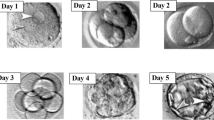Abstract
METHODS developed in an attempt to optimise the chances of identifying a teratogen generally involve the administration of the compound to a pregnant female in a number of ways, followed by autopsy about 24 h before parturition. This system maximises the period during which abnormalities may develop and circumvents loss by cannibalisation of dead or deformed newborn animals by their mother. The methodology is simple and efficient but provides no information about the immediate response of the embryo to the drug and any capability it may have for regulation or recovery from damage. Thus developmental disturbances could pass unnoticed. However, the damage, for example behavioural or reproductive abnormality, may manifest itself postnatally, and this has recently aroused some concern1,2. We report here on the mode of action of a known teratogen, mitomycin C (MMC) on mouse embryos. In rodents this antibiotic is teratogenic at high doses. In rats the LD50 and teratogenic dose seem to coincide, but for mice these figures may differ considerably3–5. Abnormalities reported include exencephaly, spina bifida6, skeletal and other non-nervous system defects7. The frequency of abnormality and dose response is strain dependent in mice. We know of no reports on the immediate response of mouse embryos to MMC and of only one on the postnatal development of mice exposed to the drug in utero in mid-gestation8. Our results indicate that, during early organogenesis stages, the mouse embryo has a remarkable capacity for recovery from severe damage and developmental retardation induced during primitive-streak stages, when drugs were thought more likely to be lethal than teratogenic.
Similar content being viewed by others
References
Wilson, J. G. Teratology 16, 227–228 (1977).
Rodier, P. M. Teratology 16, 235–246 (1977).
Chaube, S. & Murphy, M. L. Adv. Teratol. 3, 181–237 (1968).
Nishimiura, H. & Shiota, K. in Handbook of Teratology Vol. 3 (eds Wilson, J. G. & Clarke Fraser, F.) 119–154 (Plenum, New York 1977).
Wilson, J. G. Environment and Birth Defects, 148–154 (Academic, New York, 1973).
Takaya, M. Proc. congenital Anomalies Res. Ass. Jap. 3, 47–48 (1963).
Nishimiura, H. 3rd Ann. Mtng Teratol. Soc. Quebec, Abstr. (1963).
Tanaka, T. Kaibogoshu Zasshi 16, 306–312 (1966).
Ito, T. Congenital Anomalies 7, 239–249 (1967).
Fujii, Y. Congenital Anomalies 8, 219–229 (1968).
Tanimura, T. Okajimas Folia Anat. Jap. 44, 337–355 (1968).
Murphy, M. L. in Teratology, Principles and Techniques (eds Wilson, J. G. & Warkany, J.) 145–184 (Chicago University Press, Chicago, 1965).
Snow, M. H. L. Ciba Fndn Symp. 40, 53–70 (1976); J. embryol. exp. Morph. 42, 293–303 (1977).
Author information
Authors and Affiliations
Rights and permissions
About this article
Cite this article
SNOW, M., TAM, P. Is compensatory growth a complicating factor in mouse teratology?. Nature 279, 555–557 (1979). https://doi.org/10.1038/279555a0
Received:
Accepted:
Published:
Issue Date:
DOI: https://doi.org/10.1038/279555a0
- Springer Nature Limited
This article is cited by
-
P53 and mTOR signalling determine fitness selection through cell competition during early mouse embryonic development
Nature Communications (2018)
-
Effect of maternal exposure to homocystine on sodium valproate-induced neural tube defects in the mouse embryos
European Journal of Nutrition (2006)
-
Increased apoptosis and early embryonic lethality in mice nullizygous for the Huntington's disease gene homologue
Nature Genetics (1995)
-
Recovery by mouse embryos following teratogenic exposure to ketosis
Diabetologia (1991)





